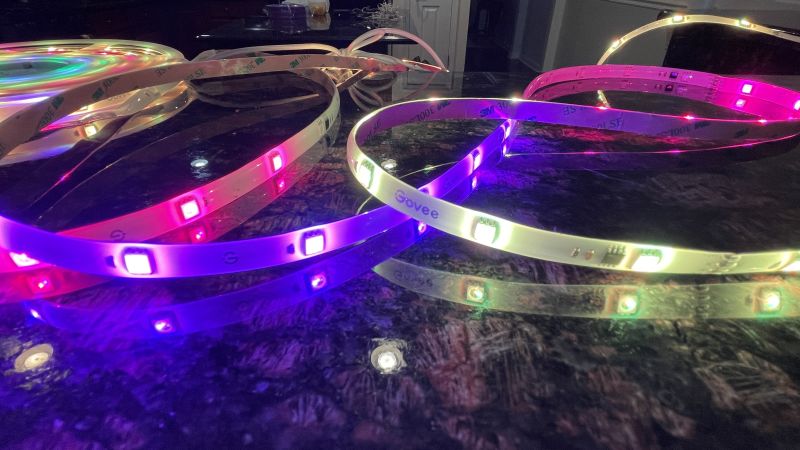LED light strips are a fun and easy way to spruce up a room, adding pops of color to a media center, a wall or even under a bed, or just bringing much-needed lighting to a dark area under a cabinet. Water-resistant versions even let you add lighting in a snap to your patio, deck or garden path. And smart strips can integrate with the rest of your lighting, or simply respond to music or other sounds around the house.
To help you figure out which LED light strip works best for your situation, we tested 10 popular models. Whether you’re looking for indoor or outdoor lighting, responsive smart strips or just something basic, we’ve found the best LED light strips available for any setting.
Govee Wi-Fi RGBIC Strip Lights
The Govee Wi-Fi RGBIC strip lights perform brilliantly and give you longer lengths and more coverage for less money than the competition. The easy-to-use app lets you create warm ambiences and color-changing special effects for entertaining or everyday use.
The Govee RGBIC Pro Smart LED strip lights give you vivid, ever changing colors, simple controls, and more coverage for your money than the competition. Smart home integrations are simple and don’t require a hub, and they’re simple to mount with a secure adhesive backing. If you’re looking for the greatest range of color effects for your money and want plenty of coverage for your money, look no further.
RGBIC light strips (IC stands for “Independent Control”) can display more than one color at a time, unlike RGB lights which only show one color. That means using the Govee app you can customize different segments of the strip to show different colors, or create lighting effects that look like the lights are jumping or cascading or chasing each other, with individual diodes turning on and off or changing color rapidly for a rolling or snake-like effect.. There are dozens of preset scenes to choose from, in addition to 11 music modes, making these great for a teen’s bedroom, a dorm room or when you’re hosting a party. They are a ton of fun to use.
The strips are voice reactive so when connected to your sound system, the lights will flash and dance in time to the music.
The light strips come in 16-foot, 32 foot and 64-foot lengths, typically divided into two reels sharing a single power adapter and control box for manual use. They’re thin, with a light coating over the diodes and very easy to bend for installation.
The lights are vivid and reasonably bright (they put out 820 lumens, similar to a string of 60w light bulbs) and true to color and can be dimmed to create ambience when needed. They can be integrated with voice assistants (Alexa and Google Assistant) without a hub giving you control over colors, schedules, music and much more. I had no issues with connectivity or placing the lights with the adhesive backing.
Govee light strips are also more affordable than others with similar features — basically you get longer lengths and more coverage for less money. Combined with the easy-to-use Govee app and color-changing special effects for entertainment and fun, these light strips will not disappoint.
Our issues with the Govee LED strips are pretty minor given the overally solid performance and value of the system.
The most frustrating downside here (which is common to all RGBIC strips) is that because of the integrated chips that allow the multiple color effects, the Govee strips can’t be cut to size, This means that unless you plan to use up an entire run (the shortest length these come in is 16 feet) illuminating your media center or gaming battle station, you may end up with a lot of excess to hide away. Govee also sells an RGB version of these, which can be trimmed to length, but the color effects are more limited and overall we prefer the RGBIC version.
Also, since Govee doesn’t include corner connectors like the Philips strips, you can’t easily make clean right angles. We ended up looping the strip under itself where we wanted to make a 90° turn, hoping it wouldn’t come away from the floor or create a dark spot at the apex of the bend.

Another issue is that while Govee makes a ton of light strip products, you can’t just add accessories to the system you already have. For instance, while the set we tested responds to sound, it doesn’t respond to on screen colors, and you can’t add just a camera — you’ll have to purchase a different light strip set, the Govee Dreamview T1 Immersion Backlights. That said, the overall cost is still lower than some systems (like the Philips) that do let you add individual components, but it’s worth keeping in mind.
In addition to a set of LED light strips, the Dreamview package comes with an external 1080p camera to capture the colors on the screen and automatically have the LEDs reproduce effects that correspond to the show or movie you’re watching, or the game you’re playing.
The best outdoor LED light strips
If you’re looking to create a colorful ambience for outdoor entertaining, Govee’s affordable Wi-Fi Outdoor Strip Lights are RGBIC, so they give you a huge range of color options, weather resistant, and easy to install and configure.
The best LED light strips for TV backlighting
Sengled’s affordable RGB light strips come in easy-to-mount lengths that save you money when mounting on a TV or monitor for backlighting effects, and have plenty of smarts to provide the perfect ambiance and audio-synchronized lighting effects for most TV or gaming situations.
The best splurge LED light strip
The Philips Hue LED light strip system looks better and is more flexible and functional than any other we tested, but it is much more expensive. If you already own other Hue smart lighting or want the very best experience, you won’t be disappointed.
|
The best LED light strips overall |
The best outdoor LED light strips |
The best LED light strips for TV backlighting |
The best splurge LED light strip |
|
|---|---|---|---|---|
| What we loved | Bright colors with multiple options, plus they are flexible, easy to install, configure and give you more coverage for less money than similarly spec’d competitors. | Lots of color possibilities and installation options in an IP65-rated weather resistant strip. | A package of precut lengths with corner connectors makes it easy to set up behind a TV or monitor without waste. | The best looking LED light strips with the most integration options and control and sync possibilities. |
| What we didn’t like | A lack of corner connectors makes tight bends difficult to negotiate during installation; adding accessories to an existing setup may mean buying more strips than you need. | Power brick isn’t water resistant and needs to be positioned in a weatherproof outlet for extended use | RGB only, so they are limited in the range of effects they can produce; can’t sync to color, only to sound. | The Philips strips are much more expensive than others, and make the most sense if you are already invested in Hue lighting in your home. |
| Key specs | RGBIC; available in 16.4 and 32.8 foot lengths; syncs to audio; available in kit with camera for color sync. | RGBIC, available in 16.4 and 32.8 foot lengths, IP65 weather resistance. | RGB, kit fits 45″ to 75″ diagonal TVs. | Available in a variety of lengths, can sync directly to HDMI input or audio with accessory, can connect with Hue bridge for integration with other Hue lighting and smart home products.. |
| Price |
$69.99 |
$72.99 |
$65.57 |
$87.95 |
These thin, flexible circuit boards are packed with small LED (Light Emitting Diode) lights that are controlled through an app and in most cases, can also use your voice with a smart speaker.
We love that they can be bent, and some can be cut to size for use around a door frame, under a cabinet or anywhere else you want to add some color. Plus, they don’t use as much electricity as incandescent bulbs and will last for years.
Though some LED light strips display only one color at a time, others can show multiple colors or dance to the beat of music allowing for endless combinations and hours of dazzling fun.
LED light strips can be installed just about anywhere you have a flat surface; under kitchen cabinets, on a back deck or patio railing or in a child’s bedroom, but it’s important to note that not all light strips work well in all locations. Some are for indoors only while others are waterproof for use outside the home. Some light strips are better for entertainment use with their ability to pulse or change colors to the beat of the music.
Whether you want lights for a TV room or a cascade of color outside, here’s what to look for when purchasing a Smart LED Light Strip.
If you already own smart lights you might want to consider strip lights from the same brand, especially if they require a hub or bridge. For instance, the Sengled and Wyze light strips we tested have Wi-Fi built in so there’s no need for a hub, while the Philips Outdoor light strip does. If you don’t already own one, you’ll be adding on the cost of the hub to the cost of the strips.
Make sure the light strips work with the smart home ecosystem you use, whether that’s Amazon Alexa, Google Assistant, or Apple HomeKit. Most work with Alexa and Google but only two that we looked at are compatible with Apple HomeKit. This is important so you can use your voice to control the light strips.
Think about where you’re placing the light strips. Under a bed or inside a bookshelf, or outside on the deck? You can put them anywhere; your only limitation is the availability of a power outlet. If placing them in a bathroom, consider a water-resistant light strip in case it gets splashed or there’s a lot of moisture.
For outdoor use, look for one with at minimum an IP44 rating, meaning the strip can get wet and withstand jets of water. An IP65 rating, like the Govee Outdoor LED Strip Lights means it can be exposed to all weather conditions.
Make sure your lights have something to reflect off. If you place them facing towards you, all you’ll see is LED lights. Unless you intend to use them to shine down and add direct light, place them facing away from you towards a wall, or the ceiling so you’ll get that diffused effect you’re looking for.
Light strips are typically held in place with double-sided adhesive on the back of the strip but some that have a heavier silicon coating or are a bit thicker and bulkier for waterproofing work better with the included mounts and screws. Be sure you’re able to use screws in whatever it is you’re mounting to before choosing this type.
The area will need to be prepped by cleaning it and wiping it down with an alcohol pad to ensure a proper hold, so make sure you have access to the entire area. Proper prep is what will keep the light strips in place.
Are the lights being used to create ambience or for entertainment? This will help you decide whether to buy ones that can display segment colors and sync with music. If you’re looking for entertainment, make sure the strips have a built-in mic to pick up the sound. For ambience, you don’t need anything more than a simple strip that shows one color at a time.
Light strips come in all different lengths so it’s important to measure the area you want to cover before you make a purchase. Some strips can be cut, others can’t, so measure twice to be sure. If you’re putting lights on the back of a TV or PC, you’ll want to choose a light strip like the Sengled Wi-Fi TV strips or the Govee Immersion TV Backlights which come in shorter lengths so there’s less waste if you need to cut to size. If you want to light the side of a wall or run it under a countertop, opt for the longer strip but be sure there’s an outlet nearby for power.
Color and Color Temperature
Most of the multi-color light strips we looked at are RGB which means they can display any combination of red, green and blue color. Typically, there are 16 million color combinations to choose from. There is no “true white” in RGB lights, but variations of white can be created.
If you’re looking for a truer white along with multi colors, then get an RGBW light strip which has a dedicated white LED alternating between the RGB diodes. These are typically a little more expensive.
Different tones of white light help create the mood in a room. Daylight white is good for home office use or anywhere you need to be focused, while warm white is perfect for creating a relaxing mood. Warm lighting is often used in the Family Room or bedroom where you’re trying to create a calming atmosphere.
Some strips can display only one color at a time, while others can be segmented, showing multiple colors at once. If you’re using the lighting to create a party atmosphere, you’ll likely want one that can show multiple colors and create fun dancing and cascading types of effects.
The brightness of LED lights is measured in lumens. For reference, a standard 60-watt light bulb gives off around 800 lumens. Most of the lights we tested give off between 1400 and 1800 making them extremely bright. They can be dimmed but it’s important to know how bright they are and how low they can be dimmed when considering what situation to place them in. Some of the ones we tried are still way too bright for a bedroom even at the dimmest setting.
Look at the number of LEDs per strip. The more LEDs there are, the more light you’ll get, and the more accurate that color will be.
Color temperature describes how warm or cool a light’s color is. Temperature is measured in Kelvin (K) degrees. Lower numbers produce a warmer temperature which gives off a yellowish tone while higher is much cooler, producing a blue tone. Most strips have a range of 2,700K to 6,500K with the higher number producing a natural daylight temperature.
We installed and tested 10 different LED light strips in different areas and locations in and out of the home. They were installed under kitchen cabinets, under a countertop, on the back of a TV, on a back deck and along a garden walkway to name a few.
We downloaded and connected the strips to the brand’s app and tested the features within the app. We looked at the user interface, judged how easy it was to set up and access preset scenes, create schedules, create music- and sound-triggered effects, set up integrations with voice assistants such as Alexa, Google, and Siri and how well the app and strips stayed connected.
We also evaluated the installation process, looking at light strip flexibility and how easy or difficult it was to bend a strip to fit the space. How the strip did on right angles and curves as a bad angle leaves it prone to peeling off too easily. We tested the special connectors some of the strips provide to create a right angle.
We tested the durability and adhesive by gently tugging on the strip a few days after installation. We tested the hold on the outdoor strips after a soaking rain.
We considered the color brightness of the strip, the length, number of LEDs as well as the ability to cut to size and how much waste is created with unused portions.
We evaluated smart home integrations and the reactive lighting (TV and music) modes on those that offer it.
Wyze Light Strips are a very inexpensive option for adding color or accent lighting to a room, and while they are very bright at 1800 lumens (perhaps due in part to the lack of a protective coating over the LEDs), we found them a bit thin and flimsy compared to the others. The RGB strips respond quickly to dimming and tuning, though you can only display one color at a time.
Like others we tested they work over Wi-Fi and Bluetooth, (no hub required) and you can use Alexa or Google Assistant voice commands to turn the lights on and off, change the color and set the brightness level. They’re easy to install, come in 16.4- and 32.8-foot lengths like much of the competition (and can be trimmed to fit, since they are RGB rather than RGBIC), and sync to music as you’d expect. More complex functions like However, to access basic preset scenes like ‘energizing’ and ‘movies’ you need to use the app. While we’d suggest spending a bit more if you can for a more durable strip, for the price they work as advertised so if you’re looking for a basic LED light strip to add a splash of color and have power available nearby, these will suit your needs.
The Wyze Light Strip Pro, the company’s RGBIC model, can display up to 16 colors per strip. It has everything the standard version has and comes in the same lengths, but it’s more customizable and gives you access to effects that sync with your games, movies and shows. You can also easily group multiple strips and control them all in the app, giving you endless hours of fun creating your own custom scenes for both lighting and music syncing.
The Pro strip has a protective epoxy coating over the LED lights so they felt a lot sturdier and less flimsy than the cheaper Wyze strips, but still don’t match the quality of our top picks. Color output also isn’t quite as true and the app is not as user friendly as the Govee and Philips strips.
If you’re looking for a bright light strip with millions of color options and don’t need an exceptionally long run, the 16.4-foot Kasa Smart Light Strip from TP-Link is an affordable RGBIC option that works with Alexa and Google Home, as well as Samsung SmartThings, but you do give up a few features for the lower price tag. There’s no audio synchronization mode so these won’t react to music or the sound from the TV, and it doesn’t offer any preset scenes to choose from in the app, only animated effects that add a flicker effect or light up certain areas of the strip.
It’s easy to install and set up, there’s no hub needed, and you can control the lights and create your own scenes to save to a preset button. You can access those presets, along with other basic controls in the app, using your voice or on the remote controller. That said, there are no corner connectors as there are for Philips or Sengled, so you’ll need to make loops in order to create 90° bends, limiting useful length.
The upgrade version, the Kasa Smart Premium LED Light Strip (KL430), comes in lengths up to 33 feet and ups the brightness of the strip from 550 to 1400 lumens, but only comes in 6.6-foot lengths, with three-foot extension kits costing about $25 each so this route will get pricey pretty quickly — at which point you might want to look to Philips Hue products.
The Kasa light strips will work well in a home that already has Kasa light switches, smart plugs or other Kasa devices in the house, as it’s really simple to set schedules and control them all in the Kasa app.
Philips Hue White and Color Ambiance Outdoor LightStrip $99.99 at Amazon
The outdoor version of the Philips Hue LED strip lights is a bulkier, rectangular affair than its indoor cousing, topped with an opaque coating that helps make this light strip weatherproof (with an IP67 rating) and diffuses the light so you see one smooth strip of colorful light rather than the individual diodes. The coating creates an illusion of one vibrant light across the whole strip and it was lovely to look at.
Unfortunately, the bulk makes the strip far less flexible, and you can’t cut or extend them, like you can the Philips Hue LightStrip Plus. I had a difficult time trying to bend it into a corner. It comes in 7- and 16-foot lengths, and can’t be cut or daisy-chained — If you need to make longer runs, you need to have another power outlet available for a new strip, limiting its usefulness on patios.
They mount with an included bracket and screw hardware system (there’s no adhesive option) which may limit your options if you rent or have HOA restrictions. I wanted to mount a 7-foot strip on my back deck but couldn’t since I live in a condo and can’t drill holes into the deck railing or the gutter. I did place it into the ground along my garden to light up the pathway, but this can only be done if you have power nearby.
The Philips Hue White and Color Ambiance Outdoor Lightstrip requires a Hue hub for voice control (Alexa, Google Voice and Apple HomeKit) and that’s a separate cost if you don’t already have one. While the light strip looks and functions beautifully, if you don’t have nearby power or can’t drill holes to mount it, you’d be better off getting our top pick, the Govee Outdoor light strip, which also costs a whole lot less.
Twinkly Dots are not technically light strips, but a Christmas-light like string of tiny LEDs that you can wrap around items like a deck rail or other curved surfaces that don’t have a flat surface for an adhesive strip. The individual dots, which are spaced an inch apart, can be put in place with adhesive, (it comes with flat dot-shaped adhesive backings) but you don’t mount the connecting wire. The special effects and premade animations were plentiful. Since each individual dot can show a different color,
As lovely as they look and as easy as they are to put in place, setup was incredibly difficult. The app — which was less intuitive than the others we tried — took over a dozen tries before it recognized our Dots over a local Wi-Fi connection. Once we got it set up, the lights offered lots of fun options and patterns, but never got very bright and often didn’t show the true color. Each time I tried to choose purple, I got variations of blue instead. They’d be fine for a party or a kids room (teens and creative users will enjoy playing with the effects and syncing the lights to music and sound) but those looking for true, bright colors may be disappointed. Dots aren’t extendable or cuttable, but they do come in a variety of sizes. You can buy strings of 60, 200, or 400 LED Dots.
These RGB Wi-Fi-enabled light strips are super bright at 1600 lumens and give you a wide variety of white light settings, but they lack some of the features that make other strip lights so fun and attractive. There’s no music sync mode, no preset scenes to choose from (though you can create your own) and the adhesive backing is not strong enough. This was the only light strip that pulled away with a slight tug once we mounted it. The strips are also the widest we tried, with a thick coating on the sides of the strip, not just over the LEDs on the front. Though meant for indoors, they looked more like the Philips strips designed for outdoor use.
The app is confusing, doesn’t properly scale for larger text sizes, and we found it difficult to set schedules and create scenes.
The strips come in 6.8 feet lengths which can be trimmed (though the cut-off sections can’t be reused). It can be daisy-chained, so you can buy and connect 3.4-foot extensions, but you’ll be spending $25 for each one. You can buy the 16-foot TP-Link Kasa light strip for a third of the price, which we recommend over this one, or step up to the Philips Hue if you want more control and synchronization options.



























































